Balbharti Maharashtra State Board 12th Biology Textbook Solutions
Chapter 2 Reproduction in Lower and Higher Animals Textbook Exercise Questions and Answers.
1. Multiple choice questions
Question 1.
The number of nuclei present in a zygote is ……………….
(a) two
(b) one
(c) four
(d) eight
Answer:
(b) one
Question 2.
Which of these is the male reproductive organ in human?
(a) Sperm
(b) Seminal fluid
(c) Testes
(d) Ovary
Answer:
(c) Testes

Question 3.
Attachment of embryo to the wall of the uterus is known as ……………….
(a) fertilization
(b) gestation
(c) cleavage
(d) implantation
Answer:
(d) implantation
Question 4.
Rupturing of follicles and discharge of ova is known as ……………….
(a) capacitation
(b) gestation
(c) ovulation
(d) copulation
Answer:
(c) ovulation
Question 5.
In human females, the fertilized egg gets implanted in uterus ……………….
(a) after about 7 days of fertilization
(b) after about 30 days of fertilization
(c) after about two months of fertilization
(d) after about 3 weeks of fertilization
Answer:
(a) after about 7 days of fertilization
Question 6.
Test tube baby technique is called ……………….
(a) In vivo fertilization
(b) In situ fertilization
(c) In Vitro Fertilization
(d) Artificial Insemination
Answer:
(c) In Vitro Fertilization
Question 7.
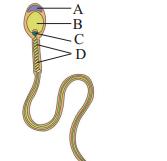
The given figure shows a human sperm. Various parts of it are labelled as A, B, C, and D. Which labelled part represents acrosome?
(a) B.
(b) C
(c) D
(d) A
Answer:
(d) A
Question 8.
Presence of beard in boys is a ……………….
(a) primary sex organ
(b) secondary sexual character
(c) secondary sex organ
(d) primary sexual character
Answer:
(b) secondary sexual character
2. Very short answer questions
Question 1.
What is the difference between a foetus and an embryo?
Answer:
Embryo is a growing egg after fertilization until the main parts of the body and the internal organs have started to take shape while foetus is a stage which has the appearance of a fully developed offspring.
Question 2.
Outline the path of sperm up to the urethra.
Answer:
The path of sperm up to the urethra in male is as follows :
Seminiferous tubules → Rete testis → Vasa efferentia → Epididymis → Vas deferens → Ejaculatory ducts Urethra.
Question 3.
Which glands contribute fluids to the semen?
Answer:
The glands which contribute fluids to the semen are seminal vesicles, prostate gland.

Question 4.
Name the endocrine glands involved in maintaining the sexual characteristics of males.
Answer:
Interstitial cells of Leydig which lie in between the seminiferous tubules are involved in maintaining the sexual characteristics of male by secreting the male hormone androgen or testosterone. Adenohypophysis also regulates this secretion from the testis.
Question 5.
Where does fertilization and implantation occur?
Answer:
Fertilization of ovum takes place in the ampulla region of fallopian tube whereas implantation occur in the endometrium of uterus.
Question 6.
Enlist the external genital organs in female.
Answer:
The external genital organs in female include the following parts such as vestibule, labia minora, clitoris, labia majora and mons Veneris.
Question 8.
What is the difference between embryo and zygote?
Answer:
Zygote is the unicellular diploid structure formed as a result of fusion of sperm and ovum whereas embryo is a multicellular structure formed from zygote in the uterus 3 weeks after fertilization.
3. Fill in the blanks
Question 1.
The primary sex organ in human male is ……………….
Answer:
testis
Question 2.
The ……………… is also called the womb.
Answer:
uterus
Question 3.
Sperm fertilizes ovum in the ……………….. of fallopian tube.
Answer:
ampulla
Question 4.
The disc like structure which helps in the transfer of substances to and from the foetus’s body is called ………………..
Answer:
placenta
Question 5.
Gonorrhoea is caused by ……………….. bacteria.
Answer:
Neisseria gonorrhoeae
Question 6.
The hormone produced by the testis is ……………………
Answer:
testosterone / androgen.
4. Short Answer Questions
Question 1.
Budding in Hydra.
Answer:
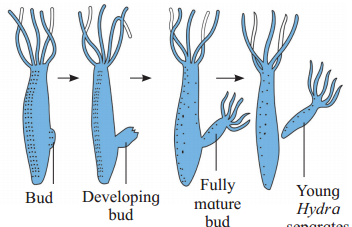
Question 2.
Explain the different methods of reproduction occurring in sponges.
Answer:

Question 3.
IVF.
Answer:
Question 4.
Comment on any two mechanical contraceptive methods.
Answer:
Two mechanical contraceptive methods are as follows:
A. Condom or Nirodh:
B. Diaphragm, cervical caps and vaults:
Question 5.
Tubectomy.
Answer:
Question 6.
Give the name of causal organism of Syphilis and write on its symptoms.
Answer:
1. Syphilis is a sexually transmitted veneral disease caused by a Spirochaete bacterium Treponema pallidum.
2. The site of infection is the mucous membrane in genital, rectal and oral region.
3. Symptoms of syphilis:
Question 7.
What is colostrum?
Answer:
5. Answer the Following Questions
Question 1.
Describe the phases of menstrual cycle and their hormonal control.
Answer:
Menstrual cycle (Ovarian cycle):
i. Menstrual cycle involves a series of cyclic, changes in the ovary and uterus. The cyclic events are regulated by gonadotropins from pituitary and the hormones from ovary.
ii. The cyclic events in woman are repeated within approximately 28 days.
iii. Menstrual cycle is divided into following phases, viz.
1. Menstrual Phase:
2. Proliferative phase/Follicular phase/Post menstrual phase:
(3) Ovulatory phase:
(4) Luteal phase/Secretary phase :
(i) Since the empty Graafian follicle converts itself into corpus luteum under the influence of LH, this phase is called luteal phase in ovary. At the same time, the uterine endometrium thickens and becomes more secretory and hence it is called secretory phase in uterus.
(ii) Corpus luteum secretes progesterone, some amount of estrogens and inhibin. These hormones stimulate the growth of endometrial glands which later start uterine secretions.
(iii) Endometrium becomes more vascularized becomes 8-10 mm. in thickness. These changes are the preparation for the implantation of the ovum if fertilization occurs.
(iv) In absence of fertilization, corpus luteum can survive for only two weeks and then degenerate into a non-secretory white scar called corpus albicans.
(v) If ovum is fertilized, woman becomes pregnant and hormone hCG (human Chorionic Gonadotropin) is secreted by chorionic membrane of embryo which keeps corpus luteum active till the formation of placenta.
Question 2.
Explain the steps of parturition.
Answer:
Parturition involves the following three steps:
1. Dilation stage:
2. Expulsion stage:
3. After birth or placental stage : In the last stage of 10 to 45 minutes, once the baby is out then the placenta is also separated from uterine wall and is expelled out as “after birth”. This is accompanied by severe contractions of the uterus.

Question 3.
Explain the histological structure of testis.
Answer:
Histological structure of testis:
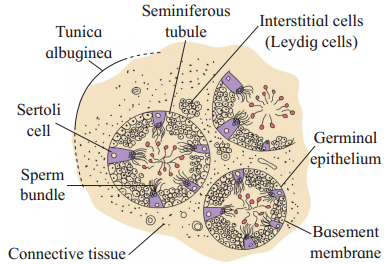
Question 4.
Describe the structure of blastocyst or blastulation
Answer:
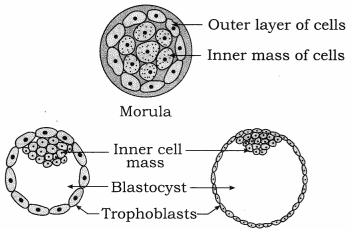
Question 5.
Explain the histological structure of ovary in human.
Answer:
Histological structure of ovary:
(1) Each ovary is a compact structure differentiated into a central part called medulla and the outer part called cortex.
(2) The cortex is covered externally by a layer of germinal epithelium while the medulla contains the stroma or loose connective tissue with blood vessels, lymph vessels and nerve fibres.
(3) Different stages of developing ovarian follicles are seen in the cortex. Each primordial follicle has at its centre a large primary oocyte (2n) surrounded by a single layer of flat follicular cells, then gradually it matures.
(4) In the ovary during each menstrual cycle there is a maturation of primordial follicles into multilayered primary, secondary and Graafian follicles.
(5) Every Graafian follicle has three layers, viz. theca externa, theca interna and membrana granulosa which are from outer to inner side. A space called antrum filled with liquor folliculi is present inside the follicle. There is a small hillock of cells called cumulus oophours or discus proligerus over which the ovum is lodged. The ovum in turn is covered by vitelline membrane, zona pellucida and corona radiata from inner side to outer surface.
(6) Ovarian cortex also shows corpus luteum, or yellow body formed from empty Graafian follicle after ovulation. Corpus luteum is converted into corpus albicans or white body in case of absence of conception.
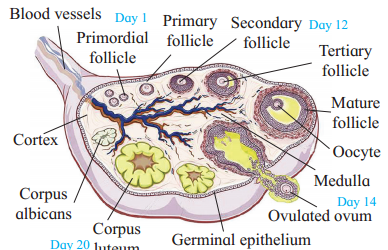
Question 6.
Describe the various methods of birth control to avoid pregnancy.
Answer:
Birth control/Contraceptive methods are of two main types, viz. temporary and permanent.
A. Temporary methods:
(1) Natural method/Safe period/Rhythm method : A week before and a week after menstrual bleeding is considered the safe period for sexual intercourse. It is based on the fact that ovulation occurs on the 14th day of menstrual cycle.
(2) Coitus Interruptus or withdrawal : In this method, the male partner withdraws his penis from the vagina before ejaculation, so as to avoid insemination. This method also has some drawbacks, as the pre-ejaculation fluid may contain sperms and this can cause fertilization.
(3) Lactational amenorrhoea (absence of menstruation) : This method is based on the fact that ovulation does not occur during the period of intense lactation following parturition so chances of conception are almost negligible. However, this method also has high chances of failure.
(4) Chemical means (spermicides) : In this method chemicals like foam, tablets, jellies and creams are introduced into the vagina before sexual intercourse, they adhere to the mucous membrane, immobilize and kill the sperms.
(5) Mechanical means/Barrier methods:
(i) Condom : It is a thin rubber sheath that is used to cover the penis of the male. Condom should be used before starting coital activity. It also prevents STDs and AIDS.
(ii) Diaphragm, cervical caps and vaults : These devices made of rubber are inserted into the female reproductive tract to cover the cervix diming copulation. They prevent conception by blocking the entry of sperms through the cervix.
(iii) Intra-uterine devices (IUDs) : These are plastic or metal objects placed in the uterus by a doctor. These include Lippes loop, copper releasing IUDs (Cu-T, Cu 7, multiload 375) and hormone releasing IUDs (LNG-20, progestasert). They prevent fertilization of the egg or implantation of the embryo.
(6) Physiological (Oral) Devices : Birth control pills (oral contraceptive pills) check ovulation as they inhibit the secretion of follicle stimulating hormone (FSH) and luteinizing hormone (LH) that are necessary for ovulation. The pill ‘Saheli’ is taken weekly.
(7) Other contraceptives : The birth control implant is similar to that of pills in their mode of action. It is implanted under the skin of the upper arm of the female.
B. Permanent methods surgical operations : In men surgical operation is called vasectomy and in women it is called tubectomy. This method blocks gamete transport and prevent pregnancy.
Question 7.
What are the goals of RCH programmes?
Answer:
Goals of RCH programmes are as follows:
Question 8.
What is parturition? Which hormones are involved in parturition?
Answer:
Question 9.
What are the functions of male accessory glands?
OR
Write a brief account of accessory sex glands associated with human male reproductive system.
Answer:
Seminal Vesicles, prostate gland and Cowper’s glands are associated with human male reproductive system.
(i) Seminal Vesicles:
(ii) Prostate gland:
(iii) Cowper’s glands (Bulbo-urethral glands):
Question 10.
What is capacitation? Give its importance.
Answer:
Long answer questions
Question 1.
Explain the following parts of male reproductive system along with labelled diagram showing these parts – Testis, vasa deferentia, epididymis, seminal vesicle, prostate gland and penis.
OR
With the help of a neat, labelled diagram, describe the human male reproductive system.
Answer:
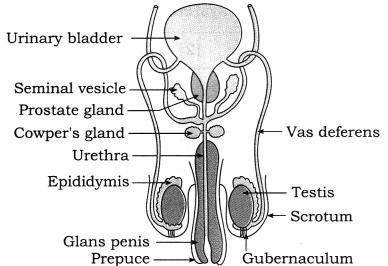
(i) Testis, the male gonad, the accessory ducts and glands along with external genitalia form the male reproductive system.
(ii) Testes:
(iii) Accessory ducts : Rete testis, vasa efferentia, epididymis, vas deferens, ejaculatory duct and urethra together form the accessory ducts of male reproductive system.
1. Vasa efferentia : Vasa efferentia are 12-20 fine tubules. They arise from rete testis and end into the epididymis. The sperms from the testis are carried by these ducts to the epididymis.
2. Epididymis : Epididymis are long and coiled tubes having three parts, viz. caput, corpus and cauda epididymis. They are located on the posterior border of each testis. The sperms undergo maturation in epididymis.
3. Vasa deferentia:
4. Ejaculatory duct : About 2 cm long pair of ducts formed by joining of vas deferens and a duct of seminal vesicle are the ejaculatory ducts. Both ejaculatory ducts open into urethra near the prostate gland. Seminal fluid containing spermatozoa are carried by ejaculatory duct to the urethra.

5. Urethra : The male urethra provides a common passage for the urine and semen hence is also called urinogenital duct.
(iv) Accessory glands : Associated with male reproductive system are : (a) Seminal vesicles (b) Prostate gland and (c) Cowper’s or Bulbourethral glands. Every accessory gland has secretion which helps in functions of reproductive system.
(v) External genitalia : External genitalia consists of penis and scrotum.
1. Penis:
2. Scrotum : The scrotum is a pouch of pigmented skin arising from lower abdominal wall. It protects testes within it. Scrotum acts as thermoregulator. Testis are suspended in scrotum by spermatic cord.
Question 2.
Describe female reproductive system of human
Answer:
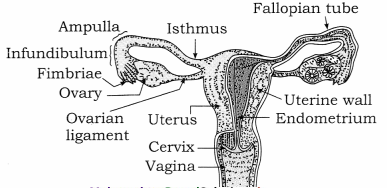
The female reproductive system consists of internal organs and external genitalia.
Internal organs are pair of ovaries and pair of fallopian ducts or oviducts, single median uterus and vagina. External genitalia is called vulva. There are a pair of vestibular glands in external genitalia. Mammary glands or breasts are also associated with reproductive system of female.
(1) Ovaries:
(2) Fallopian tubes/oviducts:
(i) Fallopian tubes lie horizontally over peritoneal cavity. These are about 10 to 12 cm long, narrow, muscular structure lined by ciliated epithelium.
(ii) They transport the ovum after ovulation from the ovary to the uterus.
(iii) Fallopian tube can be subdivided into the following three parts:
(3) Uterus/Womb:
(i) Uterus is a pear-shaped, highly muscular, thick walled, hollow organ measuring about 8 cm in length, 5 cm in width and 2 cm in thickness.
(ii) Uterus has the following three parts : Fundus, Body or corpus and Cervix.
(iii) The cervix communicates above with the body of the uterus by an aperture, the internal os and with vagina below by an opening the external os.
(iv) Uterus has three-layered wall. These layers are:
(v) Uterus receives the ovum from fallopian tube. It develops placenta during pregnancy for the nourishment of foetus. At the time of parturition, it expels the young one at birth.
(4) Vagina:
(5) External genitalia or vulva or pudendum : The external genitalia consists of five parts; viz. labia majora, labia minora, mons veneris, clitoris and vestibule.
(6) A pair of vestibular glands / Bartholin’s glands : These glands open into the vestibule and release a lubricating fluid.
(7) A pair of mammary glands/breasts : These are the accessory organs of female reproductive system for production and release of milk after parturition.
Question 3.
Describe the process of fertilization.
Answer:
(1) Fertilization is the process of fusion of the haploid male and female gametes which results in the formation of a diploid zygote (2n).
(2) In human beings fertilization is internal. Sperms deposited in vagina, swim across the uterus and fertilize the ovum in ampulla of the fallopian tube.
(3) Fertilization involves the following events:
(i) Insemination : Discharge of semen into the vagina at the time of copulation is called insemination.
(ii) Movement of sperm towards egg : Sperms reaching the vagina undergo capacitation process for 5-6 hours. During capacitation acrosomal membrane of sperm becomes thin and Ca++ enters the sperm making it extra active. Sperms reach up to the ampulla by swimming aided with contraction of uterus and fallopian tubes. These contractions are stimulated by oxytocin of female. By capacitation sperm can reach ampulla within 5 minutes, they remain 5 viable for 24 to 48 hours, whereas ovum remains viable for 24 hours.
(iii) Entry of sperm into the egg : Though many sperms reach the ampulla, only a single sperm fertilizes the ovum. The acrosome of sperm after coming in contact with the ovum, releases lysins; hyaluronidase and corona penetrating enzymes. Due to these enzymes cells of corona radiata are separated and dissolved. The sperm head then passes through zona pellucida of egg. The zona pellucida has glycoprotein fertilizin receptor proteins. These bind to specific acid protein-antifertilizin of sperm. This makes sperm and ovum to come together. Fertilizin-Antifertilizin interaction is species- specific.
(iv) Acrosome reaction : When the sperm head comes in contact with the zona pellucida, its acrosome covering ruptures to release lytic enzymes, acrosin or zona lysin. These enzymes dissolve plasma membrane of egg so that the sperm nucleus and the centrioles enter the egg, while other parts remain outside. Now the vitelline membrane of egg changes into fertilization membrane which prevents any further entry of other sperms into the egg, thus polyspermy is prevented.
(v) Activation of ovum : After the entry of sperm head into ovum, it gets activated to resume and complete its meiosis-II. With this it gives out the second polar body. The germinal vesicle organises into female pronucleus. At this stage, it is true ovum.
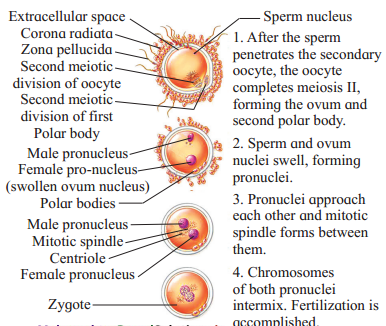
(vi) Fusion of egg and sperm : The coverings of male and female pronuclei degenerate results in the formation of a synkaryon by a process called syngamy or karyogamy. The zygote is thus formed.
Question 4.
Explain the process by which zygote divides and redivides to form the morula.
Answer:
(1) Cleavage is a rapid mitotic division to form a blastula. These divisions takes place immediately after fertilization. The cells formed by cleavage are called blastomeres.
(2) The type of cleavage in human is holoblastic, i.e. the whole zygote gets divided, radial and indeterminate, i.e. fate of each blastomere is not predetermined.
(3) Cleavage show faster synthesis of DNA and high consumption of oxygen.

(4) Since there is no growth phase between the cleavages, the size of blastomeres will be reduced with every successive cleavage.
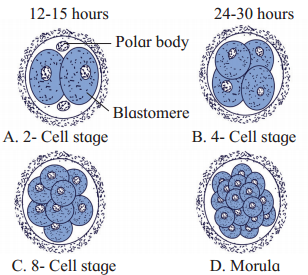
(5) The cleavages occur as follows:
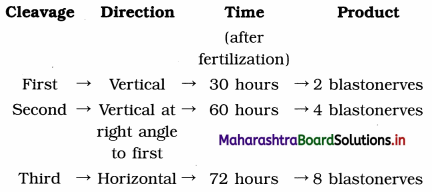
(6) Successive divisions produce a solid ball of cells called morula of 16 cells. It consists of an outer layer of smaller clearer cells and an inner mass of larger cells.
(7) Morula reaches the uterus about 4-6 days after fertilization.
Chapter 2 Reproduction in Lower and Higher Animals Textbook Exercise Questions and Answers.
1. Multiple choice questions
Question 1.
The number of nuclei present in a zygote is ……………….
(a) two
(b) one
(c) four
(d) eight
Answer:
(b) one
Question 2.
Which of these is the male reproductive organ in human?
(a) Sperm
(b) Seminal fluid
(c) Testes
(d) Ovary
Answer:
(c) Testes

Question 3.
Attachment of embryo to the wall of the uterus is known as ……………….
(a) fertilization
(b) gestation
(c) cleavage
(d) implantation
Answer:
(d) implantation
Question 4.
Rupturing of follicles and discharge of ova is known as ……………….
(a) capacitation
(b) gestation
(c) ovulation
(d) copulation
Answer:
(c) ovulation
Question 5.
In human females, the fertilized egg gets implanted in uterus ……………….
(a) after about 7 days of fertilization
(b) after about 30 days of fertilization
(c) after about two months of fertilization
(d) after about 3 weeks of fertilization
Answer:
(a) after about 7 days of fertilization
Question 6.
Test tube baby technique is called ……………….
(a) In vivo fertilization
(b) In situ fertilization
(c) In Vitro Fertilization
(d) Artificial Insemination
Answer:
(c) In Vitro Fertilization
Question 7.

The given figure shows a human sperm. Various parts of it are labelled as A, B, C, and D. Which labelled part represents acrosome?
(a) B.
(b) C
(c) D
(d) A
Answer:
(d) A
Question 8.
Presence of beard in boys is a ……………….
(a) primary sex organ
(b) secondary sexual character
(c) secondary sex organ
(d) primary sexual character
Answer:
(b) secondary sexual character
2. Very short answer questions
Question 1.
What is the difference between a foetus and an embryo?
Answer:
Embryo is a growing egg after fertilization until the main parts of the body and the internal organs have started to take shape while foetus is a stage which has the appearance of a fully developed offspring.
Question 2.
Outline the path of sperm up to the urethra.
Answer:
The path of sperm up to the urethra in male is as follows :
Seminiferous tubules → Rete testis → Vasa efferentia → Epididymis → Vas deferens → Ejaculatory ducts Urethra.
Question 3.
Which glands contribute fluids to the semen?
Answer:
The glands which contribute fluids to the semen are seminal vesicles, prostate gland.

Question 4.
Name the endocrine glands involved in maintaining the sexual characteristics of males.
Answer:
Interstitial cells of Leydig which lie in between the seminiferous tubules are involved in maintaining the sexual characteristics of male by secreting the male hormone androgen or testosterone. Adenohypophysis also regulates this secretion from the testis.
Question 5.
Where does fertilization and implantation occur?
Answer:
Fertilization of ovum takes place in the ampulla region of fallopian tube whereas implantation occur in the endometrium of uterus.
Question 6.
Enlist the external genital organs in female.
Answer:
The external genital organs in female include the following parts such as vestibule, labia minora, clitoris, labia majora and mons Veneris.
Question 8.
What is the difference between embryo and zygote?
Answer:
Zygote is the unicellular diploid structure formed as a result of fusion of sperm and ovum whereas embryo is a multicellular structure formed from zygote in the uterus 3 weeks after fertilization.
3. Fill in the blanks
Question 1.
The primary sex organ in human male is ……………….
Answer:
testis
Question 2.
The ……………… is also called the womb.
Answer:
uterus
Question 3.
Sperm fertilizes ovum in the ……………….. of fallopian tube.
Answer:
ampulla
Question 4.
The disc like structure which helps in the transfer of substances to and from the foetus’s body is called ………………..
Answer:
placenta
Question 5.
Gonorrhoea is caused by ……………….. bacteria.
Answer:
Neisseria gonorrhoeae
Question 6.
The hormone produced by the testis is ……………………
Answer:
testosterone / androgen.
4. Short Answer Questions
Question 1.
Budding in Hydra.
Answer:

Question 2.
Explain the different methods of reproduction occurring in sponges.
Answer:

Question 3.
IVF.
Answer:
Question 4.
Comment on any two mechanical contraceptive methods.
Answer:
Two mechanical contraceptive methods are as follows:
A. Condom or Nirodh:
B. Diaphragm, cervical caps and vaults:
Question 5.
Tubectomy.
Answer:
Question 6.
Give the name of causal organism of Syphilis and write on its symptoms.
Answer:
1. Syphilis is a sexually transmitted veneral disease caused by a Spirochaete bacterium Treponema pallidum.
2. The site of infection is the mucous membrane in genital, rectal and oral region.
3. Symptoms of syphilis:
Question 7.
What is colostrum?
Answer:
5. Answer the Following Questions
Question 1.
Describe the phases of menstrual cycle and their hormonal control.
Answer:
Menstrual cycle (Ovarian cycle):
i. Menstrual cycle involves a series of cyclic, changes in the ovary and uterus. The cyclic events are regulated by gonadotropins from pituitary and the hormones from ovary.
ii. The cyclic events in woman are repeated within approximately 28 days.
iii. Menstrual cycle is divided into following phases, viz.
1. Menstrual Phase:
2. Proliferative phase/Follicular phase/Post menstrual phase:
(3) Ovulatory phase:
(4) Luteal phase/Secretary phase :
(i) Since the empty Graafian follicle converts itself into corpus luteum under the influence of LH, this phase is called luteal phase in ovary. At the same time, the uterine endometrium thickens and becomes more secretory and hence it is called secretory phase in uterus.
(ii) Corpus luteum secretes progesterone, some amount of estrogens and inhibin. These hormones stimulate the growth of endometrial glands which later start uterine secretions.
(iii) Endometrium becomes more vascularized becomes 8-10 mm. in thickness. These changes are the preparation for the implantation of the ovum if fertilization occurs.
(iv) In absence of fertilization, corpus luteum can survive for only two weeks and then degenerate into a non-secretory white scar called corpus albicans.
(v) If ovum is fertilized, woman becomes pregnant and hormone hCG (human Chorionic Gonadotropin) is secreted by chorionic membrane of embryo which keeps corpus luteum active till the formation of placenta.
Question 2.
Explain the steps of parturition.
Answer:
Parturition involves the following three steps:
1. Dilation stage:
2. Expulsion stage:
3. After birth or placental stage : In the last stage of 10 to 45 minutes, once the baby is out then the placenta is also separated from uterine wall and is expelled out as “after birth”. This is accompanied by severe contractions of the uterus.

Question 3.
Explain the histological structure of testis.
Answer:
Histological structure of testis:

Question 4.
Describe the structure of blastocyst or blastulation
Answer:

Question 5.
Explain the histological structure of ovary in human.
Answer:
Histological structure of ovary:
(1) Each ovary is a compact structure differentiated into a central part called medulla and the outer part called cortex.
(2) The cortex is covered externally by a layer of germinal epithelium while the medulla contains the stroma or loose connective tissue with blood vessels, lymph vessels and nerve fibres.
(3) Different stages of developing ovarian follicles are seen in the cortex. Each primordial follicle has at its centre a large primary oocyte (2n) surrounded by a single layer of flat follicular cells, then gradually it matures.
(4) In the ovary during each menstrual cycle there is a maturation of primordial follicles into multilayered primary, secondary and Graafian follicles.
(5) Every Graafian follicle has three layers, viz. theca externa, theca interna and membrana granulosa which are from outer to inner side. A space called antrum filled with liquor folliculi is present inside the follicle. There is a small hillock of cells called cumulus oophours or discus proligerus over which the ovum is lodged. The ovum in turn is covered by vitelline membrane, zona pellucida and corona radiata from inner side to outer surface.
(6) Ovarian cortex also shows corpus luteum, or yellow body formed from empty Graafian follicle after ovulation. Corpus luteum is converted into corpus albicans or white body in case of absence of conception.

Question 6.
Describe the various methods of birth control to avoid pregnancy.
Answer:
Birth control/Contraceptive methods are of two main types, viz. temporary and permanent.
A. Temporary methods:
(1) Natural method/Safe period/Rhythm method : A week before and a week after menstrual bleeding is considered the safe period for sexual intercourse. It is based on the fact that ovulation occurs on the 14th day of menstrual cycle.
(2) Coitus Interruptus or withdrawal : In this method, the male partner withdraws his penis from the vagina before ejaculation, so as to avoid insemination. This method also has some drawbacks, as the pre-ejaculation fluid may contain sperms and this can cause fertilization.
(3) Lactational amenorrhoea (absence of menstruation) : This method is based on the fact that ovulation does not occur during the period of intense lactation following parturition so chances of conception are almost negligible. However, this method also has high chances of failure.
(4) Chemical means (spermicides) : In this method chemicals like foam, tablets, jellies and creams are introduced into the vagina before sexual intercourse, they adhere to the mucous membrane, immobilize and kill the sperms.
(5) Mechanical means/Barrier methods:
(i) Condom : It is a thin rubber sheath that is used to cover the penis of the male. Condom should be used before starting coital activity. It also prevents STDs and AIDS.
(ii) Diaphragm, cervical caps and vaults : These devices made of rubber are inserted into the female reproductive tract to cover the cervix diming copulation. They prevent conception by blocking the entry of sperms through the cervix.
(iii) Intra-uterine devices (IUDs) : These are plastic or metal objects placed in the uterus by a doctor. These include Lippes loop, copper releasing IUDs (Cu-T, Cu 7, multiload 375) and hormone releasing IUDs (LNG-20, progestasert). They prevent fertilization of the egg or implantation of the embryo.
(6) Physiological (Oral) Devices : Birth control pills (oral contraceptive pills) check ovulation as they inhibit the secretion of follicle stimulating hormone (FSH) and luteinizing hormone (LH) that are necessary for ovulation. The pill ‘Saheli’ is taken weekly.
(7) Other contraceptives : The birth control implant is similar to that of pills in their mode of action. It is implanted under the skin of the upper arm of the female.
B. Permanent methods surgical operations : In men surgical operation is called vasectomy and in women it is called tubectomy. This method blocks gamete transport and prevent pregnancy.
Question 7.
What are the goals of RCH programmes?
Answer:
Goals of RCH programmes are as follows:
Question 8.
What is parturition? Which hormones are involved in parturition?
Answer:
Question 9.
What are the functions of male accessory glands?
OR
Write a brief account of accessory sex glands associated with human male reproductive system.
Answer:
Seminal Vesicles, prostate gland and Cowper’s glands are associated with human male reproductive system.
(i) Seminal Vesicles:
(ii) Prostate gland:
(iii) Cowper’s glands (Bulbo-urethral glands):
Question 10.
What is capacitation? Give its importance.
Answer:
Long answer questions
Question 1.
Explain the following parts of male reproductive system along with labelled diagram showing these parts – Testis, vasa deferentia, epididymis, seminal vesicle, prostate gland and penis.
OR
With the help of a neat, labelled diagram, describe the human male reproductive system.
Answer:

(i) Testis, the male gonad, the accessory ducts and glands along with external genitalia form the male reproductive system.
(ii) Testes:
(iii) Accessory ducts : Rete testis, vasa efferentia, epididymis, vas deferens, ejaculatory duct and urethra together form the accessory ducts of male reproductive system.
1. Vasa efferentia : Vasa efferentia are 12-20 fine tubules. They arise from rete testis and end into the epididymis. The sperms from the testis are carried by these ducts to the epididymis.
2. Epididymis : Epididymis are long and coiled tubes having three parts, viz. caput, corpus and cauda epididymis. They are located on the posterior border of each testis. The sperms undergo maturation in epididymis.
3. Vasa deferentia:
4. Ejaculatory duct : About 2 cm long pair of ducts formed by joining of vas deferens and a duct of seminal vesicle are the ejaculatory ducts. Both ejaculatory ducts open into urethra near the prostate gland. Seminal fluid containing spermatozoa are carried by ejaculatory duct to the urethra.

5. Urethra : The male urethra provides a common passage for the urine and semen hence is also called urinogenital duct.
(iv) Accessory glands : Associated with male reproductive system are : (a) Seminal vesicles (b) Prostate gland and (c) Cowper’s or Bulbourethral glands. Every accessory gland has secretion which helps in functions of reproductive system.
(v) External genitalia : External genitalia consists of penis and scrotum.
1. Penis:
2. Scrotum : The scrotum is a pouch of pigmented skin arising from lower abdominal wall. It protects testes within it. Scrotum acts as thermoregulator. Testis are suspended in scrotum by spermatic cord.
Question 2.
Describe female reproductive system of human
Answer:

The female reproductive system consists of internal organs and external genitalia.
Internal organs are pair of ovaries and pair of fallopian ducts or oviducts, single median uterus and vagina. External genitalia is called vulva. There are a pair of vestibular glands in external genitalia. Mammary glands or breasts are also associated with reproductive system of female.
(1) Ovaries:
(2) Fallopian tubes/oviducts:
(i) Fallopian tubes lie horizontally over peritoneal cavity. These are about 10 to 12 cm long, narrow, muscular structure lined by ciliated epithelium.
(ii) They transport the ovum after ovulation from the ovary to the uterus.
(iii) Fallopian tube can be subdivided into the following three parts:
(3) Uterus/Womb:
(i) Uterus is a pear-shaped, highly muscular, thick walled, hollow organ measuring about 8 cm in length, 5 cm in width and 2 cm in thickness.
(ii) Uterus has the following three parts : Fundus, Body or corpus and Cervix.
(iii) The cervix communicates above with the body of the uterus by an aperture, the internal os and with vagina below by an opening the external os.
(iv) Uterus has three-layered wall. These layers are:
(v) Uterus receives the ovum from fallopian tube. It develops placenta during pregnancy for the nourishment of foetus. At the time of parturition, it expels the young one at birth.
(4) Vagina:
(5) External genitalia or vulva or pudendum : The external genitalia consists of five parts; viz. labia majora, labia minora, mons veneris, clitoris and vestibule.
(6) A pair of vestibular glands / Bartholin’s glands : These glands open into the vestibule and release a lubricating fluid.
(7) A pair of mammary glands/breasts : These are the accessory organs of female reproductive system for production and release of milk after parturition.
Question 3.
Describe the process of fertilization.
Answer:
(1) Fertilization is the process of fusion of the haploid male and female gametes which results in the formation of a diploid zygote (2n).
(2) In human beings fertilization is internal. Sperms deposited in vagina, swim across the uterus and fertilize the ovum in ampulla of the fallopian tube.
(3) Fertilization involves the following events:
(i) Insemination : Discharge of semen into the vagina at the time of copulation is called insemination.
(ii) Movement of sperm towards egg : Sperms reaching the vagina undergo capacitation process for 5-6 hours. During capacitation acrosomal membrane of sperm becomes thin and Ca++ enters the sperm making it extra active. Sperms reach up to the ampulla by swimming aided with contraction of uterus and fallopian tubes. These contractions are stimulated by oxytocin of female. By capacitation sperm can reach ampulla within 5 minutes, they remain 5 viable for 24 to 48 hours, whereas ovum remains viable for 24 hours.
(iii) Entry of sperm into the egg : Though many sperms reach the ampulla, only a single sperm fertilizes the ovum. The acrosome of sperm after coming in contact with the ovum, releases lysins; hyaluronidase and corona penetrating enzymes. Due to these enzymes cells of corona radiata are separated and dissolved. The sperm head then passes through zona pellucida of egg. The zona pellucida has glycoprotein fertilizin receptor proteins. These bind to specific acid protein-antifertilizin of sperm. This makes sperm and ovum to come together. Fertilizin-Antifertilizin interaction is species- specific.
(iv) Acrosome reaction : When the sperm head comes in contact with the zona pellucida, its acrosome covering ruptures to release lytic enzymes, acrosin or zona lysin. These enzymes dissolve plasma membrane of egg so that the sperm nucleus and the centrioles enter the egg, while other parts remain outside. Now the vitelline membrane of egg changes into fertilization membrane which prevents any further entry of other sperms into the egg, thus polyspermy is prevented.
(v) Activation of ovum : After the entry of sperm head into ovum, it gets activated to resume and complete its meiosis-II. With this it gives out the second polar body. The germinal vesicle organises into female pronucleus. At this stage, it is true ovum.

(vi) Fusion of egg and sperm : The coverings of male and female pronuclei degenerate results in the formation of a synkaryon by a process called syngamy or karyogamy. The zygote is thus formed.
Question 4.
Explain the process by which zygote divides and redivides to form the morula.
Answer:
(1) Cleavage is a rapid mitotic division to form a blastula. These divisions takes place immediately after fertilization. The cells formed by cleavage are called blastomeres.
(2) The type of cleavage in human is holoblastic, i.e. the whole zygote gets divided, radial and indeterminate, i.e. fate of each blastomere is not predetermined.
(3) Cleavage show faster synthesis of DNA and high consumption of oxygen.

(4) Since there is no growth phase between the cleavages, the size of blastomeres will be reduced with every successive cleavage.

(5) The cleavages occur as follows:

(6) Successive divisions produce a solid ball of cells called morula of 16 cells. It consists of an outer layer of smaller clearer cells and an inner mass of larger cells.
(7) Morula reaches the uterus about 4-6 days after fertilization.